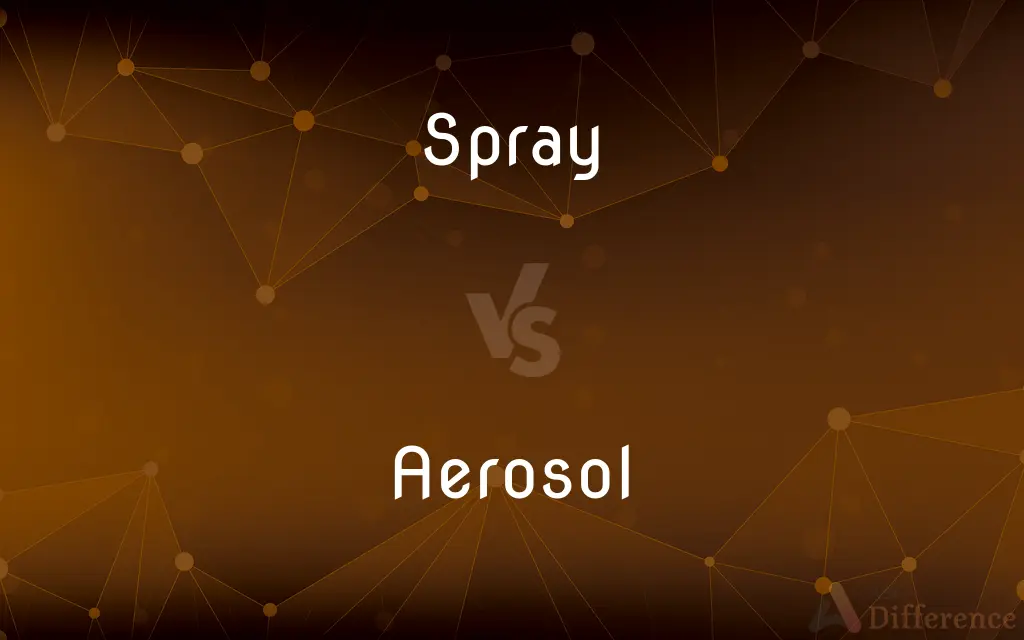Spray vs. Aerosol — What's the Difference?
By Tayyaba Rehman & Maham Liaqat — Updated on April 1, 2024
Spray refers to liquid droplets dispersed in air, typically from a bottle with a pump action, while aerosol denotes fine particles or droplets suspended in a gas, often emitted from a pressurized container.

Difference Between Spray and Aerosol
Table of Contents
ADVERTISEMENT
Key Differences
A spray is a broad term that describes any liquid propelled in a fine mist, often used in cleaning products, perfumes, and more. It relies on mechanical means, such as a pump or trigger, to disperse the liquid. On the other hand, an aerosol is a type of spray that specifically uses pressurized gas to atomize and propel the liquid or particles, found in products like spray paint and deodorants.
When considering environmental impact, sprays can be more eco-friendly, especially those that use mechanical pumps, which don’t rely on propellant gases. Aerosols, however, have been criticized for their use of propellants that can be harmful to the ozone layer, although modern aerosols use more environmentally friendly propellants.
From a usage standpoint, sprays offer a direct and controlled application, making them suitable for tasks requiring precision or a gentle application, like watering plants or applying hair products. Aerosols provide a finer mist that can cover a larger area more evenly, ideal for painting, applying deodorants, or disinfecting surfaces.
The technology behind each is different; sprays work through mechanical action, requiring manual effort to release the liquid. Aerosols, however, use chemical propellants within a sealed container to create a consistent, pressurized mist without the need for manual pumping.
In terms of product formulation, spray products may contain a simpler mixture of liquids, easily dispensed through manual pumps. Aerosol products often include a mixture of liquid, solvent, and propellant designed to work in harmony to ensure the product is expelled correctly and efficiently.
ADVERTISEMENT
Comparison Chart
Propulsion Method
Mechanical (pump, trigger)
Pressurized gas (propellant)
Environmental Impact
Lower (if not using propellants)
Higher (due to propellants, though modern options are more eco-friendly)
Application
Direct, controlled
Fine mist, wide coverage
Technology
Manual effort required
Chemical propellants for consistent mist
Product Formulation
Simpler liquid mixtures
Liquid, solvent, and propellant mixture
Compare with Definitions
Spray
Liquid dispersed in a fine mist.
She used a spray bottle to mist her plants.
Aerosol
A product that produces a fine mist.
The doctor recommended an aerosol inhaler for his asthma.
Spray
A device that emits liquid in a fine stream.
The gardener attached a spray nozzle to the hose.
Aerosol
Particles or droplets suspended in gas.
The room was freshened with an aerosol deodorizer.
Spray
Act of applying liquid in mist form.
He used a water spray to cool down the air.
Aerosol
Environmental concern due to propellants.
Modern aerosols use eco-friendly propellants to minimize impact.
Spray
A product designed to be applied as a mist.
The stylist used a hair spray for hold.
Aerosol
A pressurized container that dispenses a substance.
She shook the aerosol can before spraying.
Spray
The range or reach of a sprayed substance.
The spray from the waterfall reached the tourists.
Aerosol
Use of pressurized gas for dispersion.
The artist applied paint using an aerosol can.
Spray
Water or other liquid moving in a mass of dispersed droplets, as from a wave.
Aerosol
An aerosol is a suspension of fine solid particles or liquid droplets in air or another gas. Aerosols can be natural or anthropogenic.
Spray
A moving mass of particles or projectiles
A spray of bullets.
Aerosol
A gaseous suspension of fine solid or liquid particles.
Spray
A fine jet of liquid discharged from a pressurized container.
Aerosol
The spray of fine particles of a substance, such as paint, asthma medication, or insecticide, that is released from an aerosol can.
Spray
A pressurized container; an atomizer.
Aerosol
An aerosol can.
Spray
Any of numerous commercial products, including paints, cosmetics, and insecticides, that are dispensed from containers in this manner.
Aerosol
A mixture of fine solid particles or liquid droplets suspended in a gaseous medium.
Spray
A small branch bearing buds, flowers, or berries.
Aerosol
An aerosol can.
Spray
Something, such as a decorative motif, that resembles such a branch.
Aerosol
The payload (e.g. insecticide, paint, oil, cosmetics) and propellant contained by an aerosol can.
Spray
To disperse (a liquid, for example) in a mass or jet of droplets, particles, or small pieces.
Aerosol
(physics) A colloidal system in which the dispersed phase is composed of either solid or liquid particles and in which the dispersal medium is some gas, usually air.
Spray
To apply a spray to (a surface); hit with a spray.
Aerosol
(transitive) To spray with an aerosol.
Spray
To discharge sprays of liquid.
Aerosol
A cloud of solid or liquid particles in a gas
Spray
To be directed or dispersed in a spray.
Aerosol
A dispenser that forces a liquid out as a fine spray when a button is pressed
Spray
(Zoology) To urinate on various objects as a way of marking territory.
Spray
A fine, gentle, dispersed mist of liquid.
The sailor could feel the spray from the waves.
Spray
(figuratively) Something resembling a spray of liquid.
Spray
(countable) A pressurized container; an atomizer.
Spray
(countable) Any of numerous commercial products, including paints, cosmetics, and insecticides, that are dispensed from containers in this manner.
Spray
A jet of fine medicated vapour, used either as an application to a diseased part or to charge the air of a room with a disinfectant or a deodorizer.
Spray
A side channel or branch of the runner of a flask, made to distribute the metal to all parts of the mold.
Spray
A group of castings made in the same mold and connected by sprues formed in the runner and its branches.
Spray
The allocation and filling of blocks of memory with the same byte sequence, hoping to establish that sequence in a certain predetermined location as part of an exploit.
Spray
(Australia) A loud scolding or reprimand, usually delivered by a sports coach or similar figure.
Spray
(countable) A small branch of flowers or berries.
The bridesmaid carried a spray of lily-of-the-valley.
Spray
(countable) A collective body of small branches.
The tree has a beautiful spray.
Spray
(uncountable) Branches and twigs collectively; foliage.
Spray
An orchard.
Spray
(countable) An ornament or design that resembles a branch.
Spray
(transitive) To project a liquid in a dispersive manner toward something.
The firemen sprayed the house.
Using a water cannon, the national guard sprayed the protesters.
Spray
(ergative) To project in a dispersive manner.
Spray some ointment on that scratch.
The water sprayed out of the hose.
Spray
To project many small items dispersively.
Spray
To urinate in order to mark territory.
Spray
To allocate blocks of memory from (a heap, etc.), and fill them with the same byte sequence, hoping to establish that sequence in a certain predetermined location as part of an exploit.
To spray the heap of a target process
Spray
To pass (a ball), usually laterally across the field and often a long distance.
Spray
To kick (a ball) poorly and in an unintended direction.
Spray
To give unwanted advice.
Spray
A small shoot or branch; a twig.
The painted birds, companions of the spring,Hopping from spray to spray, were heard to sing.
Spray
A collective body of small branches, or cut flowers with long stems; as, the tree has a beautiful spray; many sprays were sent in condolence to teh funeral home.
And from the trees did lop the needless spray.
Spray
A side channel or branch of the runner of a flask, made to distribute the metal in all parts of the mold.
Spray
Water flying in small drops or particles, as by the force of wind, or the dashing of waves, or from a waterfall, and the like.
Spray
A jet of fine medicated vapor, used either as an application to a diseased part or to charge the air of a room with a disinfectant or a deodorizer.
Spray
To let fall in the form of spray.
Spray
To throw spray upon; to treat with a liquid in the form of spray; as, to spray a wound, or a surgical instrument, with carbolic acid.
Spray
A pesticide in suspension or solution; intended for spraying
Spray
A dispenser that turns a liquid (such as perfume) into a fine spray
Spray
A quantity of small objects flying through the air;
A spray of bullets
Spray
Flower arrangement consisting of a single branch or shoot bearing flowers and foliage
Spray
Water in small drops in the atmosphere; blown from waves or thrown up by a waterfall
Spray
A jet of vapor
Spray
Be discharged in sprays of liquid;
Water sprayed all over the floor
Spray
Scatter in a mass or jet of droplets;
Spray water on someone
Spray paint on the wall
Spray
Cover by spraying with a liquid;
Spray the wall with paint
Common Curiosities
What is the main difference between spray and aerosol?
The main difference lies in their propulsion methods: sprays use mechanical means, while aerosols use pressurized gas.
Are all sprays aerosols?
No, not all sprays are aerosols; sprays can be simple mechanical pump actions without pressurized gas.
Why choose a spray over an aerosol?
Sprays are often chosen for their direct, controlled application and potentially lower environmental impact.
How do aerosols work?
Aerosols work by using a chemical propellant in a sealed container to atomize and expel the substance as a fine mist.
Can spray containers be reused?
Many spray containers, especially those with mechanical pumps, can be refilled and reused.
How do aerosol propellants affect the ozone layer?
Historically, some aerosol propellants harmed the ozone layer, but newer formulations are designed to be ozone-friendly.
What applications are best for aerosols?
Aerosols are best for applications requiring fine, even coverage over a larger area, such as painting or disinfecting.
What is a common use for spray technology?
A common use is in household cleaning products and personal care items like perfumes and hair sprays.
What are the health considerations with aerosol use?
Health considerations include potential respiratory irritation from inhaling particles, especially in poorly ventilated areas.
Is it safe to inhale aerosols?
Inhalation safety depends on the substance being sprayed; always use as directed and ensure good ventilation.
Why might someone prefer a pump spray to an aerosol?
They may prefer the manual control, the absence of propellants, and the potential for refilling and reusing the container.
Can aerosols be eco-friendly?
Yes, modern aerosols use environmentally friendly propellants to reduce environmental impact.
What innovations have been made in aerosol technology?
Innovations include eco-friendly propellants, improved nozzle designs for better mist distribution, and product formulations for health safety.
Can the term 'spray' also refer to the action of applying the product?
Yes, 'spray' can refer to both the product form and the action of dispersing the product as a fine mist.
How do aerosol and spray packaging impact product design?
Packaging impacts the product's use, with aerosols requiring sealed, pressurized containers and sprays needing pump-action mechanisms.
Share Your Discovery

Previous Comparison
Flogging vs. Scourge
Next Comparison
Household vs. DomesticAuthor Spotlight
Written by
Tayyaba RehmanTayyaba Rehman is a distinguished writer, currently serving as a primary contributor to askdifference.com. As a researcher in semantics and etymology, Tayyaba's passion for the complexity of languages and their distinctions has found a perfect home on the platform. Tayyaba delves into the intricacies of language, distinguishing between commonly confused words and phrases, thereby providing clarity for readers worldwide.
Co-written by
Maham Liaqat














































